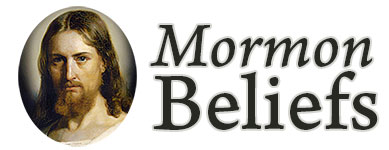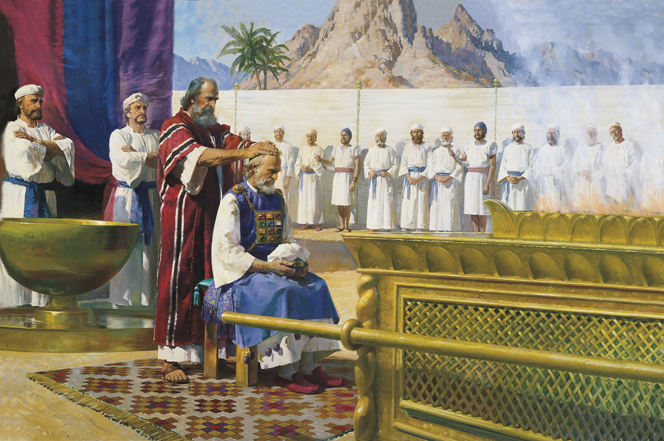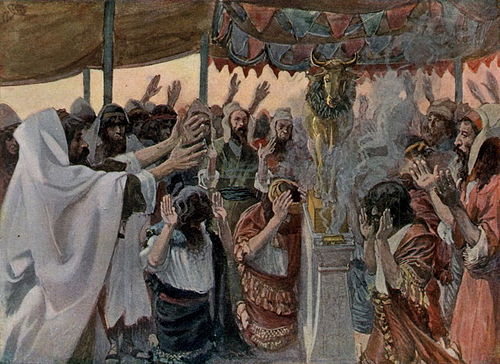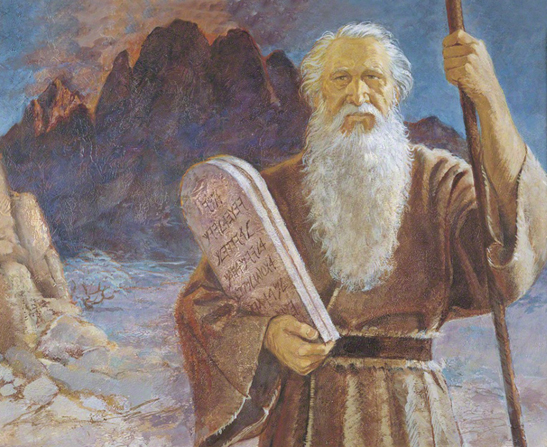This is the last in a four-part series about Moses and the Exodus.
With Moses and the children of Israel out of Egypt and safely in the wilderness, the time had come for the next phase of this Old Testament prophet’s mission—to lead the people out of spiritual bondage completely. Mormon scholar S. Kent Brown, professor of ancient scripture at Brigham Young University, wrote:
Having proved that he was the faithful God, the Lord was ready to make a covenant with the former slaves.
This was the only path to true freedom. The Lord God had carefully orchestrated a set of miracles and experiences to guide the children of Israel in a set direction. But He could not make them choose to follow Him and obey His commandments. That could only come from within.
The Abrahamic Covenant
The children of Israel were the posterity of Abraham, Isaac and Jacob. Thus, they were heirs to the Abrahamic covenant. Mormon scholar Rodney Turner explained:
Abraham was to lay the foundation of a great work. He was to be patriarch of a people chosen to carry the gospel to all mankind. His family was to be the [light unto the world] (Matthew 5:14). Following the birth of his twelve sons, Jacob, the grandson of Abraham, was given a new name: Israel, which means “ruling with God.” In its ultimate sense, it denotes those men and women who obtain exaltation….
Covenants have an important function to the people of God. Mormon historian David J. Whittaker, at the time a professor of Latter-day Saint Church history and doctrine at Brigham Young University, wrote:
Ancient Israel claimed a divine relationship identified as a covenant between the people and God. This covenant relationship, making Israel separate from her neighbors, demanded that ancient Israelites have yada for their God, as he had for them. The Hebrew verb yada (or da’ath) is usually translated “to know” or “to be acquainted with.” But the covenant context adds both a mental and an emotional act. …
Yada describes the covenant relationship of mutual obligation and concern between God and Israel, his people.
This was the relationship that God sought to renew with the children of Israel—to bring them into His presence. (See Doctrine & Covenants 84:23.)
The Preparatory Gospel
The gospel of Jesus Christ consists of both a lower and a higher law. The lower law prepares one to receive the higher law—and, ultimately, to enter the presence of God. The preparatory gospel consists of the gospel of repentance, baptism, remission of sins and the law of carnal commandments (such as the law of Moses). (See Doctrine & Covenants 84:26-27.)
Mormon scholar Bruce Satterfield, professor of religion at Brigham Young University—Idaho, explained:
The first step in becoming “an holy nation” (or Zion society) worthy of entering the presence of God was for the children of Israel to enter into the preparatory gospel by covenant. Exodus 19-24 gives an account of the children of Israel entering into the preparatory gospel by covenant. To prepare for the covenant, the children of Israel were sanctified and their clothes were washed (Exodus 19:10-11). The mountain was also prepared by establishing a border around the base between the people and the mountain with the injunction that no one was to touch the border or pass beyond it lest they should be put to death (Exodus 19:12-13). On the third day, the Lord descended on top of the mountain, his divine presence being represented by “fire and smoke” (Exodus 19:16-25). In the hearing of the Israelites, the Lord gave to Moses the 10 commandments (or “carnal commandments”) as part of the preparatory gospel (Exodus 20; Deuteronomy 5).
This, however, was a step below what the Lord had offered to the children of Israel. Mormon scholar Ellis T. Rasmussen explained:
If they had accepted all of the privileges offered them and followed the instructions which would have qualified them to receive the fulfillment of all God’s promises, they could have been accorded the grandest of all revelations: He offered to come down in the sight of all the people and let them hear when He spoke to Moses that they might know for themselves about His will and His law, and believe in Moses’ future revelations from God, and revere the Lord evermore (cf. Deuteronomy 4:10). Note the need of cleanliness and spiritual dedication in their preparation for this great spiritual experience.
At the prearranged signal, the sounding of the trumpet “exceeding long,” the people trembled in anticipation and awe, but apparently they were not fully ready to come up “in the sight” of the Lord on the mount where Moses was, for the Lord told him to go down and warn them not to come up. … But even though their hearts were not fully prepared to endure His presence, they did hear the voice and the words of God as the Ten Commandments were given…. (Rasmussen, Introduction to the Old Testament, 1:83.)
Although the children of Israel were not prepared to see God, they were faithful in making and keeping the preparatory commandments. Professor Satterfield continued:
Exodus 24 records the ritual the Israelites participated in when they entered into the covenant where they promised to obey the 10 commandments. After putting the covenant into writing, Moses built an altar at the base of the mountain and placed twelve stones representing the twelve tribes of Israel around the altar. Moses then read to the children of Israel the terms of the covenant. In response, the Israelites said, “All that the Lord hath said will we do, and be obedient.” Then Moses sprinkled the blood of sacrificed animals on the altar (representing God) and the children of Israel (most likely the twelve stones) suggesting the retributive nature of the covenant (the same as when the Lord passed between the pieces of the severed animals in Genesis 15). That is, if the children of Israel broke their covenant they would suffer death even as the sacrifices from whom the blood had come. Moses referred to this as the “blood covenant” in these terms: “Behold the blood of the covenant which the Lord hath made with you concerning all these words” (Exodus 24:8).
President James E. Faust explained the importance of these covenants:
Covenants are not simply outward rituals; they are real and effective means of change.
The children of Israel were now the covenant people of the Lord. But the Lord had greater blessings in store for them if they would remain faithful.
The Higher Law
After entering into the preparatory covenant with God, the children of Israel were ready to receive the higher law. Thus, God again summoned Moses up to Mount Sinai. Here, Moses received instructions on the higher law for 40 days and nights. Professor Satterfield wrote:
During this time, Moses received the higher law. Then the details of both the preparatory and higher gospel were written on the tables of stone “with the finger of God” (Exodus 31:18).
While on the mount, Moses not only received the tables of stone upon which the fullness of the gospel was written but he also received detailed instructions concerning the building of a portable temple commonly called the Tabernacle wherein the ordinances of both the preparatory gospel and the higher law could be performed (Exodus 25-31). The Hebrew name of the Tabernacle is ohel mo’ed, which is best translated “tent of meeting.” This is an appropriate name for this structure because the Tabernacle was the place where the Israelites were to prepare to meet God and live in his presence.
This tabernacle had a very distinct purpose for the children of Israel. Elder L. Tom Perry explained:
In order that they would have a centerpiece for their worship and activity, the Lord instructed Moses to build a tabernacle. The tabernacle was a forerunner of the temple, made portable so they could easily carry it with them.
Indeed, in this portable tabernacle the Lord intended for the children of Israel to pass through several areas symbolic of their covenants with Him. Professor Satterfield wrote:
It appears from Doctrine & Covenants 84:19-24, that the Lord initially intended that the children of Israel would pass through the ordinances of both the preparatory gospel (performed in the courtyard) and higher gospel (performed in the holy place) thus qualifying them to come into his presence symbolized by the passing through the veil into the most holy place (where God’s presence was represented by the ark).
These were to be the crowning blessings for the children of Israel.
The Tragedy of the Golden Calf
While Moses was on the mount receiving instructions for the higher law, the children of Israel grew impatient. Exodus 32:1 explains:
And when the people saw that Moses delayed to come down out of the mount, the people gathered themselves together unto Aaron, and said unto him, Up, make us gods, which shall go before us; for as for this Moses, the man that brought us up out of the land of Egypt, we wot not what is become of him.
To Mormon scholar Paul Y. Hoskisson, professor of ancient scripture at Brigham Young University, this reaction is understandably human. He wrote:
… The Israelites had passed from Egyptian slavery into one terrifying experience after another. By the time Aaron made the golden calf, Moses, who had visibly wrought miracles in their presence and who had more than once occasioned their physical safety, had been missing for almost forty days. Anyone who is a stranger to the Near Eastern deserts, as the Israelites must have been after more than one generation in Egypt, knows how frightening the absence of an individual for even one or two days can be. Thus, the demands of the people and Aaron’s acquiescence, though improper, seem all too human.
Elder Perry said:
Aaron succumbed to the will of the people and told them to gather all their gold and silver and precious things and melt them into a form that made a golden calf, an idol that they could worship and carry with them as they journeyed. In the meantime, Moses was receiving the two tablets of testimony containing God’s commandments to His people.
Professor Turner wrote:
Note that the people attributed their deliverance to Moses, not to God. These Israelites could not rid themselves of the slave mentality. When it is a bondage of the spirit, not even God can free an individual or a people if there is no will to be free.
The Israelites lacked the intelligence, the light, and truth either to become free or to remain free. They were so ignorant and naive that they ascribed their deliverance to the idol that they had fashioned with their own hands!
It is important to note that not all of the children of Israel were involved in this idol worship, but many of them were. That any were involved is a tragedy. Cecil B. DeMille, producer of the movie The Ten Commandments, said:
Some, who do not know either the Bible or human nature, may see in the orgy of the Golden Calf only a riot of Hollywood’s imaginations—but those who have eyes to see will see in it the awful lesson of how quickly a nation or a man can fall, without God’s law.
If man will not be ruled by God, he will certainly be ruled by tyrants—and there is no tyranny more imperious or more devastating than man’s own selfishness, without the law.
We cannot break the Ten Commandments. We can only break ourselves against them—or else, by keeping them, rise through them to the fulness of freedom under God. God means us to be free. With divine daring, He gave us the power of choice. (Commencement Address, Brigham Young University Speeches of the Year, Provo, 31 May 1957.)
And with that power of choice, some of the children of Israel were turning against the God who had delivered them.
Aaron and the Idol
It is curious that Aaron would give in to the people’s demand for an idol. It is equally curious that the people would demand an idol. But Professor Hoskisson explained that the children of Israel had a difficult time letting go of their “considerable Egyptian cultural baggage.” This, however, does not explain Aaron’s actions. Professor Hoskisson wrote:
I suggest that the golden calf or young bull (the Hebrew word means “a young ox or bull”) was not a pagan god. Rather, it was a symbol of the God of Israel. …
When the calf was completed, the people spoke of the calf as being the “elohim, O Israel,” that brought them out of Egypt. While it is true that elohim can be used in the Hebrew Bible to refer to pagan gods, its predominant use is for the God of Israel. Almost as a confirmation of the Israelite nature of the calf, Aaron then declared, “Tomorrow is a feast to Jehovah.” If the calf had been a pagan god or pagan symbol, Aaron would not have proclaimed a feast to “Jehovah” nor would the people have said with reference to the calf, “These be thy elohim.” And when God told Moses what was happening, he made no mention of a pagan god, just that the Israelites “have made them a molten calf, and have worshipped it, and have sacrificed thereunto, and said, These be thy elohim, O Israel.” …
I need to point out specifically, however, that the calf was not a representation of the God of Israel—it was merely a symbol of Jehovah, perhaps even of his pedestal.
Thus, Aaron did not make a pagan god for the people to worship. What, then, was the nature of his sin? Professor Hoskisson explained:
Aaron’s sin … was not so much in making a likeness of a calf but, rather, in allowing the image of a calf, even if it was a symbol of Jehovah and not of a pagan god, to be used in a significant way in the “feast to Jehovah.” After the construction of the calf, Aaron allowed the people to declare, “These be thy elohim, O Israel, which have brought thee up out of the land of Egypt.” He then built an altar in front of the calf, and the people offered sacrifices to the calf during a “feast to Jehovah.” The calf had been allowed to become a central figure in the Israelite religious services.
Of Aaron, Bible scholar Adam Clarke wrote:
Possibly he only intended to make them some symbolical representation of the Divine power and energy, that might be as evident to them as the pillar of cloud and fire had been, and to which God might attach an always present energy and influence; or in requiring them to sacrifice their ornaments, he might have supposed they would have desisted from urging their request: but all this is mere conjecture, with very little probability to support it. It must however be granted that Aaron does not appear to have even designed a worship that should supersede the worship of the Most High … and we find farther that some of the proper rites of the true worship were observed on this occasion, for they brought burnt-offerings and peace-offerings, verses 6, 7: hence it is evident he intended that the true God should be the object of their worship, though he permitted and even encouraged them to offer this worship through an idolatrous medium, the molten calf.” (Clarke, Bible Commentary, 1:463–64.)
The Broken Covenant
When the Israelites made their golden calf, they violated the Ten Commandments. Moses was still on the mount with God. The scriptures state:
And the Lord said unto Moses, Go, get thee down; for thy people, which thou broughtest out of the land of Egypt, have corrupted themselves:
They have turned aside quickly out of the way which I commanded them…. I have seen this people, and, behold, it is a stiffnecked people: Now therefore let me alone, that my wrath may wax hot against them, and that I may consume them: and I will make of thee a great nation. (Exodus 32:7-10)
Professor Satterfield wrote:
Hence, the covenant was broken, forcing God into the position of executing the demands of the broken covenant: Israel must be destroyed! At the moment God was going to satisfy justice, Moses interceded in behalf of his people, reminding God of the covenant he made with Abraham, saying, “Remember Abraham, Isaac, and Israel, thy servants, to whom thou swarest by thine own self, and saidst unto them, I will multiply your seed as the stars of heaven, and all this land that I have spoken of will I give unto your seed, and they shall inherit it for ever” (Exodus 32:13). In response, the Lord said: “If they will repent of the evil which they have done, I will spare them, and turn away my fierce wrath; but, behold, thou shalt execute judgment upon all that will not repent of this evil this day” (JST Exodus 32:14). We find within this story Moses as a type of Christ wherein he demonstrates the mediatorial role of Christ. Further, this story illustrates the powerful role of the Abrahamic covenant in the salvation of Israel.
When Moses came off the mount he found the children of Israel participating in the … cult worship. He threw down the tables of stone breaking them as a sign of the broken covenant and the loss of the higher law they would have received (Exodus 32:19). He then stood outside of the camp and cried, “Who is on the LORD’s side?” (Exodus 32:26). Those repenting of their actions came to where Moses was standing while the rest were executed by the tribe of Levi (Exodus 32:27-29).
The Ten Commandments
In His mercy, the Lord allowed the children of Israel to repent of the evil they had done. Moses returned to Mount Sinai, where he again spoke with God. Professor Satterfield wrote:
The Lord then commanded Moses to “hew two other tables of stone” whereon the terms and conditions of a new covenant was written. This included everything that was written on the first set of tables “save the words of the everlasting covenant of the holy priesthood” or the higher ordinances of the temple (JST Deuteronomy 10:2; JST Exodus 34:1,2; Doctrine & Covenants 84:23-27). In other words, the higher gospel … was removed thus denying the children of Israel the ordinances that would enable them to come into the presence of the Lord.
In place of the higher gospel, Moses received what became known as the “law of Moses” (much of which is found in the Books of Leviticus, Numbers, and Deuteronomy). The prophet Abinadi said that the law of Moses was “a law of performances and ordinances, a law which they [Israel] were to observe strictly from day to day, to keep them in remembrance of God and their duty towards him” (Mosiah 13:30). The Apostle Paul taught that it was intended to be a “schoolmaster” that would “bring [Israel] unto Christ” and the higher law (Galatians 3:24). Essentially, the law of Moses was a set of laws that were given to the Israelites that might be thought of as object lessons that illustrated the importance of the preparatory gospel and explain how it functioned. Hense, the preparatory gospel was the focus of the law of Moses. This law was not only to be the religous code of the Israelites but also their civil code.
After returning from the mount with the new set of stone tablets, Moses explained the new law and covenant to the children of Israel (Ex. 34:29-35:19). Then the children of Israel entered into a covenant to keep the law of Moses (Ex. 34:27-28). This covenant replaced the covenant the children of Israel had made in Exodus 24.
And, it would appear, many renewed their faithfulness and received great blessings. One of the ways in which they showed this faith was in the building of the tabernacle. The Latter-day Saint Old Testament Student Manual explains:
It is significant that, before revealing the pattern of the tabernacle itself, the Lord told Moses that Israel had to demonstrate a willingness to sacrifice to build His sanctuary (see Exodus 25:2). Mormon taught that if a gift of sacrifice is offered to the Lord with a grudging attitude, not only is it not acceptable to the Lord, but it becomes an evil act (see Moroni 7:6–10). Unless Israel had the right attitude about the sacrifice of their materials, it would do them no good. Modern readers should remember that despite their other faults and failings (the golden calf episode took place while Moses was on the mount receiving this revelation), when Israel heard what the Lord asked, they responded with joyous liberality. Their hearts were indeed touched (see Exodus 35:20–22, 25–26, 29), and finally Moses had to restrain them, for they gave far more than was needed for the tabernacle (see Exodus 36:5–7).
In Exodus 25:8 the Lord clearly revealed the purpose for the tabernacle—it was to be the house of the Lord. The Hebrew word which is translated “tabernacle” actually means “tent” or “dwelling” (Wilson, Old Testament Word Studies, s.v. “tabernacle,” p. 434).
Thus, many of the children of Israel had fully turned themselves back to their God. Mormon scholar Sidney B. Sperry wrote:
The Israelites were taught the fundamentals of religion when they were given the Ten Commandments and other teachings. Some of them doubtless joined the church, but it is also clear that many didn’t or were considered unworthy. (See 1 Corinthians 10:1–8; Doctrine & Covenants 84:24.) In time, even the higher ordinances of the gospel were revealed by Moses, at least to some.
The extent to which the children of Israel found complete freedom from the chains of spiritual bondage depended upon how completely the came to rely upon God. Those who gave themselves fully to Him found complete freedom. Elder H. Ross Workman said:
How, then, does one “shake off the awful chains” of spiritual captivity? As we purify our hearts through repentance and turn to the Savior with a firm determination to obey His commandments, He will enlarge our strength through the power of His grace. Each righteous choice we make can then lead to future righteous choices. The struggle to escape spiritual captivity and regain our freedom is not always an easy process; indeed, it may lead us through the refiner’s fire. But because of the Atonement and the great gift of repentance, “though [our] sins be as scarlet, they shall be as white as snow” (Isaiah 1:18).
1. Moses & the Exodus: The Lord Prepares a People and a Prophet
2. Moses and the Exodus: Pharaoh and the Plagues
3. Moses and the Exodus: Leading the Children of Israel out of Bondage
4. Moses and the Exodus: The Quest to Become a Covenant People



